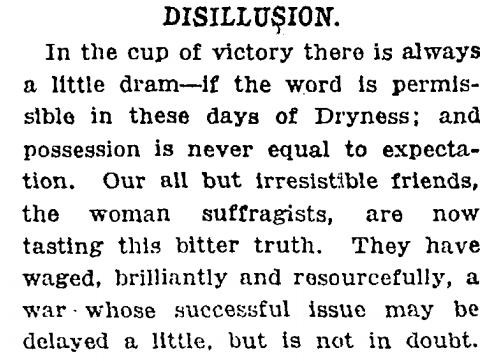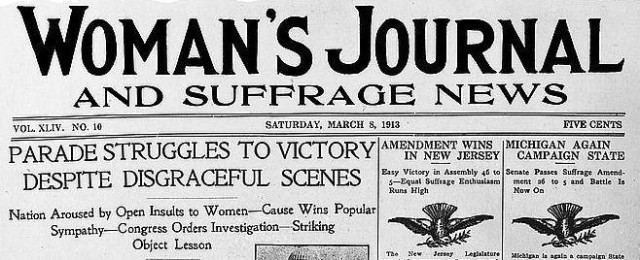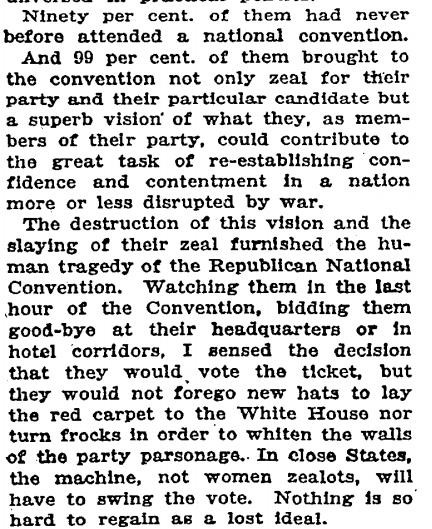The 'Times' As Tardy Leader and the History of Women's Suffrage
by Jane Hu

The New York Times addresses current issues in three ways: as expressions of guidance on the editorial page, as expressions of individual opinion on the op-ed page, and as worthy (or not) of news coverage or analysis in the rest of the paper. It has grappled with how to cover Israel, for instance. And for the last 30 years, it has struggled with how to cover gay people. Now the paper has moved in all three departments from following to leading, from first using the word “homosexual” in 1926 to (tardily) using the word “gay” to pioneering gay wedding announcements. What can we learn about the paper’s process of leading, following or getting out of the way from its coverage of the women’s suffrage movement — and of the relationship of this coverage to future successes of social movements?
By 1920, women’s campaign for suffrage in the United States had dragged on for too long. The movement — generally cited as instigated at the 1848 Seneca Falls convention for women’s rights — was in its seventh decade when the 19th Amendment was passed.
Wyoming Territory had already granted women suffrage in 1869. Before the end of the century, Wyoming, Colorado, Utah and Idaho had all approved state suffrage. When Washington ratified suffrage on March 22, 1920, the United States had seen 35 states admit the female vote. With only one more state needed to effect a constitutional amendment, August 1920 still found many anti-suffragist men and women who opposed ratification by a 36th state. Even after Tennessee provided the final 36th ratification, suffragist opposition wholeheartedly believed that the amendment would never pass the House.
And when it did, newspapers across the country declared the age of the woman’s movement as over. Having received their long sought-after vote, what else might there to left to desire?
It might be easy to recognize now how such constitutional milestones only gesture (and quite belatedly) toward the pervasive social processes and tensions of a culture. While the struggle for sexual equality did not end on August 18th, neither did it begin with the 1848 convention. Yet, one’s inclination to view “movements” as bracketed by locatable historical moments is perhaps even more significant in regards to the suffragists, who expanded the means of articulating what defined a feminist “moment” via print culture. As Elizabeth Cady Stanton declared at the 1848 convention: “He has compelled her to submit to laws, in the formation of which she has no voice.” The decades leading up to the 19th Amendment involved a growing emergence of a public female voice via suffragist newspapers, journals, and pamphlets. Through these dominantly female-run and -read publications, suffragists engendered a material reality for a public that was largely — if at all — viewed in the abstract.
Understanding that to be heard is to be read, suffragists sought to express themselves in print. Stanton and Susan B. Anthony first published their feminist newspaper The Revolution in January 1868. Two years later, Lucy Stone and husband established The Woman’s Journal (later bought by Carrie Chapman Catt and turned into the official journal of the Woman Suffrage Party in New York). Other notable suffragists also founded newspapers, as in the case of Alice Paul’s weekly The Suffragist in November 1913. These are a notable few of the many that gained popularity in the United States (London experienced its suffragists’ presses earlier and more militant).

To their contributors, Stanton and Anthony advised, “Don’t preach. Don’t even exhort. Don’t philosophize. Above all, don’t sentimentalize. Give us facts and experience in words, if you please, as hard as cannon balls.” While Stanton and Anthony warned against impassioned language, their paper was nonetheless seen as the more extreme of the suffragist presses. In Voices of Revolution: the Dissident Press in America, Rodger Streitmatter observes how “The Revolution’s editorial agenda was too radical even for most supporters of women’s suffrage.” New York’s Commercial Advertiser characterized The Revolution as “Amazonian.”
And the Times depicted the paper as “meaningless,” foolish,” and “a victim of illogical thinking.” (The New York Sun, in its turn, described Anthony and Stanton with equally inventive adjectives: “The quiet duties of daughter, wife or mother are not congenial to these hermaphrodite spirits who thirst to win the title of champion of one sex and victor over the other.”) Although these anti-suffrage presses — unsurprisingly run, in large, by men — did belittle the push for women’s enfranchisement, they were, perhaps more tellingly, for the most part relatively quiet on the topic.
Many editors saw the suffrage movement as a “woman’s story” that required a female perspective and, for the most part, suffrage news didn’t make the paper at all. Archives of the Times reveal their suffrage-related articles distinctly increase during the 1908 rise of militant suffragism and the seasons leading up to the final 1920 amendment. Finding it enough to oppose suffrage flat-out, the Times hardly bothered to defend their stance. Perhaps evidence of how little their readers needed convincing, the Times mainly printed fact-based reports on elections and rallies, rather than opinions. Starting in January 1920, each time a state ratified suffrage, the Times would make a short mention of vote ratios on their front page.
Beyond this, the Times would occasionally demonstrate their view of the whole matter through a few patronizing — if at least sympathetic — editorials.
One June 4, 1920, editorial titled “Disillusion,” filled with rhetorical questions, reads like a Victorian yellowback:
“Woman, lovely woman, ah, where and what is she in the fateful hours when the cards are being stacked and the cunning old players are reckoning up their possible points? The women folks are allowed and urged to vote. Each side adores their votes and woman suffrage more than the other. Is voting all they have to do? Is a national convention, after all, a lodge meeting where women are admitted to the public entertainment but can have no hand in the business, which is transacted in rooms carefully protected from feminine visitors? Is politics a game of skill which politicians, for all their flatteries and fine words, don’t think women fit to play? Are women welcome only in the election booth, but excluded from the arcane councils where the men they are to vote for are named? What sort of equality of sexes is this? The women have the show, the men the substance.
Therefore is there a little sadness, mingled, perhaps, with surprise and resentment, in many suffrage bosoms. […] There is a big speck within the garnered fruit. A shade of disillusion darkles on the joy. They deserve the most respectful sympathy. They are finding out how much juggling, false pretense and humbug there is in this wicked world of trousered politicans.”
Another July 16 editorial, “Parties and Suffrage,” is unabashed in its derision for politics but also for earnestness, and therefore equal rights:
“The hopes and fears, whether real or feigned, of candidates and parties about woman suffrage belong really to the national stock of humor. Each party is perfectly willing to give the women the right to vote. Possibly it is not the sanest and wisest way of dealing with a permanent change in the political life of the United States to bid for it, as each party does. Except for that, there probably isn’t the shadow of the faintest line of political strength, one way or the other, in the whole business.
The women folks are sure to get the vote by Federal amendment. The men are falling over one another in their natural anxiety to show the earnest depth and profound conviction of politics and politicians.”
When it came to printing the opinions of others, the Times knew who to approach:
“Women are the best thing God ever made,” prefaced a legislator in black alpaca, “and I would not pollute them by allowing them to wade through the filthy waters of politics. My wife, nine daughters and eight daughters-in-law think I can represent them at the polls and I guess what’s good enough for them will have to be good enough for the rest.”

The Times did finally allow a few female perspectives onto their pages. Playwright and journalist Anna Steese Richardson published two long editorials on the Republican and Democratic conventions titled Lesson Women Learned at Chicago and Women at Two Conventions respectively. Writing in a tone unlike anything else the Times printed on suffragism, Richardson’s pieces underscore the divide between so-called masculine objectivity and feminine affect. By attributing such impassioned prose to a female byline, the Times could label suffrage as a female concern: one that elicited emotion over straight facts. Yet, Richardson’s reports also offered readers something else that the Times had refused to provide until then — a plurality of perspectives. Reporting from the stands, Richardson aims to place the reader amid the various women attending the convention:
“One of them advised me that the problem of her local committee was to get in touch with the common people, to make politics interesting to the masses of women. Another said that it is frightfully difficult to regulate the size of contributions from newly rich women who wished to climb socially through political benefactions.”
The playwright in Richardson knows how to set a scene and goes on to describe a range of women diverse in their interests. Moving among the suffragists, she presents the possibility of vast differences between citizens ultimately striving for the same goal.
By illustrating how those identified as suffragists cannot be easily defined or delimited, Richardson suggests how little the reader might comprehend about the movement. Against the closed doors, which the Disillusion editorial allows only for male occupancy, Richardson emphasizes that women have been toiling at their own quiet work: “The real doings were conducted by small groups, close corporations of experienced women, behind closed doors.” And these experienced women “were there for the purpose of learning more about [the democratic] party, its methods, its policies and its leaders. They demanded facts, and woe unto the man who offered them less.”
And she explained the experience of attendees.

Once ratification by a 36th state appeared in its impending state on the near horizon, editorials quickly turned to look toward the future. The writer in “To Educate Our Rulers” poses the question: “With ratification of the Suffrage Amendment now virtually assured, the country will begin to ask, What next is to be done?” After this initial sign of hopeful projection, the article quickly regresses:
“The attainment of the right of suffrage is only the beginning of a long experiment, beset by many difficulties. Some of them are appalling. There is, for example, the question of the colored woman in the South. There are the foreign-born women of the great cities in the North. There are the sheltered classes and the ignorant classes. Will they not feel ‘the weight of too much liberty’?”
Now that women will soon have the vote, the writer suggests that the future will hold women interests as unnecessary and obsolete:
“We mean the intolerance, the intense sex-consciousness, the angry assaults, the resentments, the absorption in a single aim […]. With the vote won, there will be no need for the employment of such weapons, if there ever was. The women voters must expect to merge into the general mass. They can no longer stand as a class, or ‘interest,’ apart.”
Such sentiments might be premature, but they are also in part archaic notions of femininity. Read against Richardson’s articles, this editorial fails to offer any persuasive image of a viable future for the sexless “general mass.” And most of the paper follows this idea of the suffrage movement as enclosed in bubble — a time capsule that affected, at most, only one generation of women.
Among the many editorials that ridiculed suffragism, one published two days after the August 18 ratification strikes an unusual tone of sincerity in its hesitancy:
“public men in all times have been tempted to exaggerated speech. Even bearing this in mind, it is a bit daunting to read some of the superlatives used about the triumph of woman suffrage. Governor Cox leaves most competitors far behind by his assertion that through the vote of the Tennessee Legislature ‘the civilization of the world is saved.’ If that were so, we had all better abandon campaigns and elections and at once order our ascension robes….
False hopes will be roused. People will expect the political millennium to dawn immediately; but it will not. Worse than that, exuberant rejoicing will tend to make the country forget the grave perils which go along with the full enfranchisement of women. It is a time for reflection, for serious study, for sober taking of counsel, not for sounding the loud timbrel.
The true importance of the suffrage movement — inadequately represented throughout the pages of the Times — emerges briefly in this editorial. The call “for reflection, for serious study” is why one might seek to read the Times retrospectively — an analysis that leads, for the most part, to dead ends. Especially now as the paper turns once again toward new and future changes, we might reconsider how a single press — powerful then and still now — shaped and guarded a population’s definition of citizenship. As “movements” pass through the pages of the Times, readers and writers are urged to reevaluate the legal, moral and rhetorical definitions of citizenship so that they might finally refine them.
The contents of a newspaper are, by definition, perpetually in flux. But not by much. Only when seen from enough of a vantage does a long-standing press expose its lack of narrative sense and instability of narrative authority. Immediately, one perceives editorials diverge and short-circuit into the multiple perspectives so easily offered up in Richardson’s pieces. A distant reading of the Times reveals just how much it has ideologically shifted with the culture it speaks for, and how much it has yet to.
Jane Hu is our official correspondent for very recent history.
